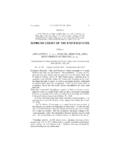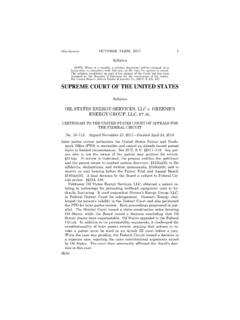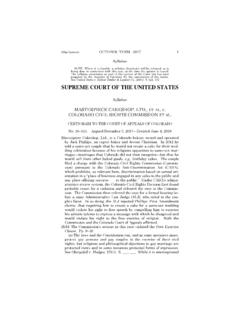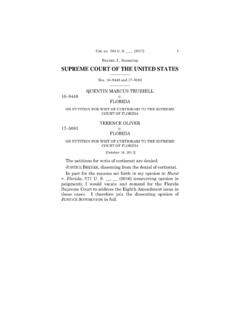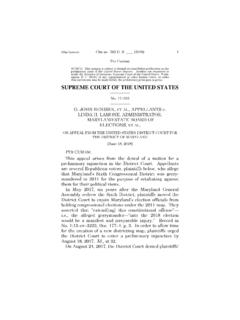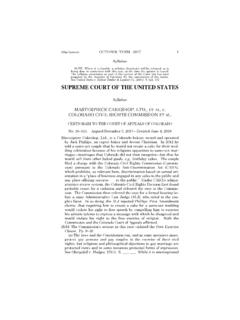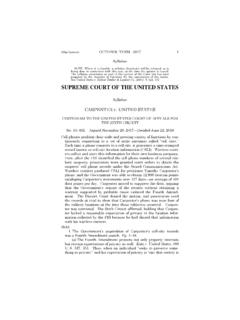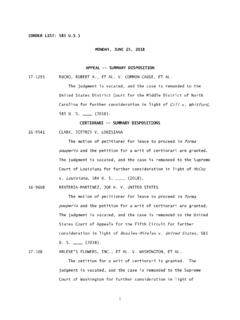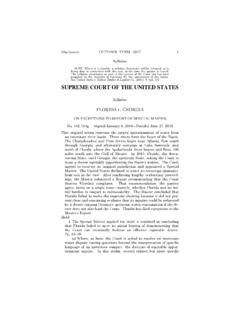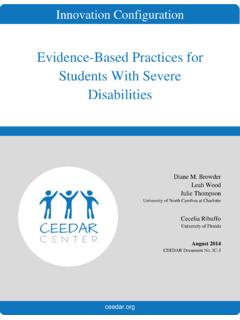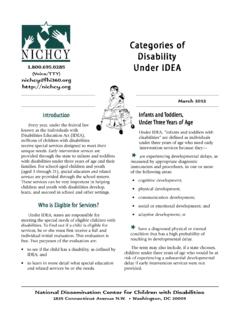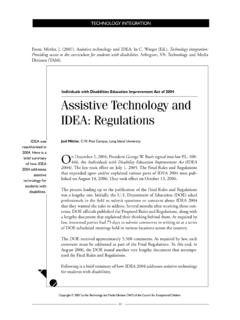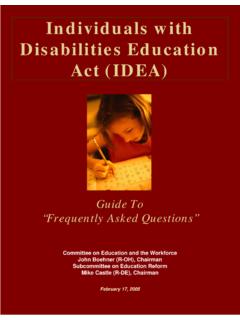Transcription of SUPREME COURT OF THE UNITED STATES
1 1 (Slip Opinion) OCTOBER TERM, 2016 Syllabus NOTE: Where it is feasible, a syllabus (headnote) will be released, as isbeing done in connection with this case, at the time the opinion is syllabus constitutes no part of the opinion of the COURT but has beenprepared by the Reporter of Decisions for the convenience of the reader. See UNITED STATES v. Detroit Timber & Lumber Co., 200 U. S. 321, 337. SUPREME COURT OF THE UNITED STATES Syllabus ENDREW F., A MINOR, BY AND THROUGH HIS PARENTS AND NEXT FRIENDS, JOSEPH F. ET AL. v. DOUGLAS COUNTY SCHOOL DISTRICT RE 1 CERTIORARI TO THE UNITED STATES COURT OF APPEALS FOR THE TENTH CIRCUIT No.
2 15 827. Argued January 11, 2017 Decided March 22, 2017 The individuals with disabilities education Act (IDEA) offers Statesfederal funds to assist in educating children with disabilities . The Act conditions that funding on compliance with certain statutory re-quirements, including the requirement that STATES provide every eli-gible child a free appropriate public education , or FAPE, by meansof a uniquely tailored individualized education program, or IEP. 20 U. S. C. 1401(9)(D), 1412(a)(1). This COURT first addressed the FAPE requirement in Board of Ed. of Hendrick Hudson Central School Dist., Westchester Cty.
3 V. Rowley, 458 U. S. 176. The COURT held that the Act guarantees a substantive-ly adequate program of education to all eligible children, and thatthis requirement is satisfied if the child s IEP sets out an educationalprogram that is reasonably calculated to enable the child to receive educational benefits. Id., at 207. For children fully integrated inthe regular classroom, this would typically require an IEP reasona-bly calculated to enable the child to achieve passing marks and ad-vance from grade to grade. Id., at 204. Because the IEP challenged in Rowley plainly met this standard, the COURT declined to establishany one test for determining the adequacy of educational benefits conferred upon all children covered by the Act, instead confin[ing]its analysis to the facts of the case before it.
4 Id., at 202. Petitioner Endrew F., a child with autism, received annual IEPs in respondent Douglas County School District from preschool throughfourth grade. By fourth grade, Endrew s parents believed his aca-demic and functional progress had stalled. When the school district proposed a fifth grade IEP that resembled those from past years, En- 2 ENDREW F. v. DOUGLAS COUNTY SCHOOL DIST. RE 1 Syllabus drew s parents removed him from public school and enrolled him in aspecialized private school, where he made significant district representatives later presented Endrew s parents witha new fifth grade IEP, but they considered it no more adequate thanthe original plan.
5 They then sought reimbursement for Endrew s private school tuition by filing a complaint under the IDEA with the Colorado Department of education . Their claim was denied, and a Federal District COURT affirmed that determination. The Tenth Cir-cuit also affirmed. That COURT interpreted Rowley to establish a rule that a child s IEP is adequate as long as it is calculated to confer an educational benefit [that is] merely .. more than de minimis, 798 F. 3d 1329, 1338 (internal quotation marks omitted), and concluded that Endrew s IEP had been reasonably calculated to enable [him]to make some progress, id.
6 , at 1342 (internal quotation marks omit-ted). The COURT accordingly held that Endrew had received a FAPE. Held: To meet its substantive obligation under the IDEA, a school must offer an IEP reasonably calculated to enable a child to make progressappropriate in light of the child s circumstances. Pp. 9 16.(a) Rowley and the language of the IDEA point to the approachadopted here. The reasonably calculated qualification reflects arecognition that crafting an appropriate program of education re-quires a prospective judgment by school officials, informed by their own expertise and the views of a child s parents or guardians; any re-view of an IEP must appreciate that the question is whether the IEPis reasonable, not whether the COURT regards it as ideal.
7 An IEP must aim to enable the child to make progress; the essential function of an IEP is to set out a plan for pursuing academic and functional ad-vancement. And the degree of progress contemplated by the IEPmust be appropriate in light of the child s circumstances, which should come as no surprise. This reflects the focus on the particularchild that is at the core of the IDEA, and the directive that STATES of-fer instruction specially designed to meet a child s unique needs through an [i]ndividualized education program. 1401(29), (14) (emphasis added). Rowley sheds light on what appropriate progress will look like in many cases: For a child fully integrated in the regular classroom, anIEP typically should be reasonably calculated to enable the child to achieve passing marks and advance from grade to grade.
8 458 U. S., at 204. This guidance is grounded in the statutory definition of a FAPE. One component of a FAPE is special education , defined as specially designed instruction .. to meet the unique needs of a childwith a disability. 1401(9), (29). In determining what it means to meet the unique needs of a child with a disability, the provisions of the IDEA governing the IEP development process provide guidance. 3 Cite as: 580 U. S. ____ (2017) Syllabus These provisions reflect what the COURT said in Rowley by focusing on progress in the general education curriculum.
9 1414(d)(1)(A)(i) (I)(aa), (II)(aa), (IV)(bb). Rowley did not provide concrete guidance with respect to a childwho is not fully integrated in the regular classroom and not able toachieve on grade level. A child s IEP need not aim for grade-level ad-vancement if that is not a reasonable prospect. But that child s edu-cational program must be appropriately ambitious in light of his cir-cumstances, just as advancement from grade to grade is appropriately ambitious for most children in the regular classroom. The goals may differ, but every child should have the chance to meet challenging standard is more demanding than the merely more than de minimis test applied by the Tenth Circuit.
10 It cannot be right that the IDEA generally contemplates grade-level advancement for chil-dren with disabilities who are fully integrated in the regular class-room, but is satisfied with barely more than de minimis progress for children who are not. Pp. 9 15.(b) Endrew s parents argue that the Act goes even further and re-quires STATES to provide children with disabilities educational oppor-tunities that are substantially equal to the opportunities affordedchildren without disabilities . Brief for Petitioner 40. But the lower courts in Rowley adopted a strikingly similar standard, and thisCourt rejected it in clear terms.
